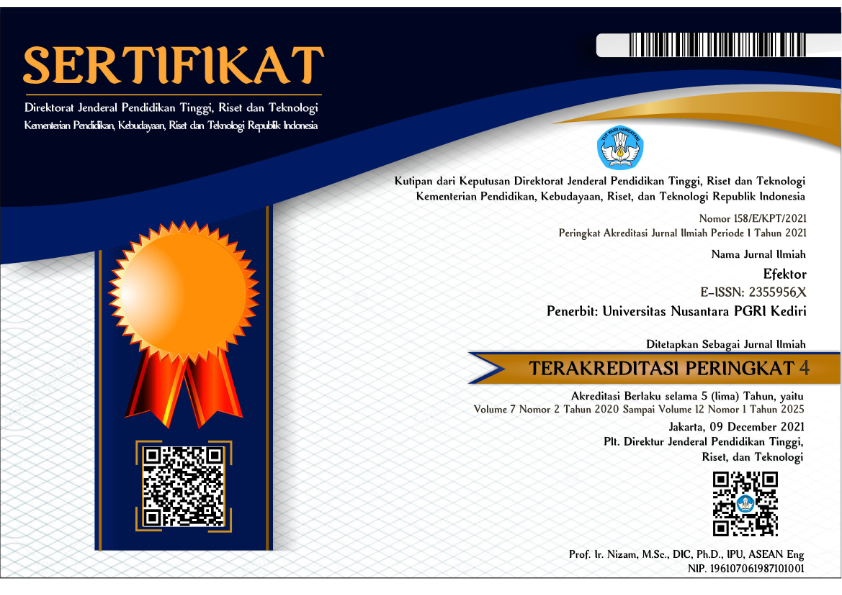Perbedaan Experienced Workplace Incivility Ditinjau Dari Status Pegawai Dan Jenis Kelamin Pada Tenaga Kependidikan
DOI:
https://doi.org/10.29407/e.v9i1.17706Keywords:
experienced workplace incivility, employee status, genderAbstract
The purpose of this research was to examine the difference between experienced workplace incivility based on the status of employe and gender. Quantitative method used in this research. The population in this study were the employee of X University with saturated sampling technique, the total respondents of 52 employees (25 jobhoders and 27 contract employees; 19 man and 33 woman). The instrument used was the experienced workplace incivility scale consisting of 7 items. Data analysis in this research used independent sample t-test. This study found that the hypothesis was rejected (p > 0.05), so there is no difference in experienced workplace incivility based on the status of employee and gender. This research findings extend past research on wokplace incivility especially for educational staff in university.
References
Abid, G., Khan, B., Rafiq, Z., & Ahmed, A. (2015). Workplace Incivility: Uncivil Activites, Antecedents, Consequences; and Level of Incivility. Sci.Int.(Lahore), 27 (6), 6307-6312.
Andersson, L. M., & Pearson, C. M. (1999). Tit fro Tat? The Spiraling Effect of Incivility in the Workplace. The Academy of Management Review , 452-471.
Azwar, S. (2016). Metode Penelitian. Yogyakarta: Pustaka Pelajar.
Backhaus, R., Beerens, H. C., Van Rossum, E., Verbeek, H., & Hamers, J. (2018). Rethinking the Staff-Quality Relationship in Nursing Homes. Journal of Nutrition, Health and Aging. 22 (6), 634-638.
Banjarani, D. R., & Andreas, R. (2019). Pelaksanaan dan Perlindungan Akses Hak Pekerja Wanita di Indonesia: Telaah Undang-Undang No. 13 Tahun 2003 tentang Ketenagakerjaan atas Konvensi ILO. Jurnal HAM. 10 (1), 115-126.
Boshra, H. N., Ogaard, T., & Roislien, J. (2022). Workplace Incivility and Turnover Intention in Organizations: A Meta-Analytic Review. Environmental Research and Public Health , 25 (1), 1-19.
Cooke, H. A., & Baumbusch, J. (2020). Not Just How Many but Who Is on Shift: The Impact of Workplace Incivility and Bullying on Care Delivery in Nursing Homes. The Gerontologist , 61 (4), 563-572.
Cortina, L. M., Kabat-Farr, D., Leskinen, E. A., Huerta, M., & Magley, V. J. (2013). Selective incivility as modern discrimination in organizations: Evidence and Impact. Journal of Management, 39(6), 1579–1605.
Cortina, L. M., Magley, V. J., Williams, J. H., & Langhout, R. D. (2001). Incivility in the Workplace: Incidence and Impact. Journal of Occupational Health Psychology , 6 (1), 64-80.
Handoyo, S., Samian, Syarifah, D., & Suhariadi, F. (2018). The Measurement of Workplace Incivility in Indonesia: Evidence and Construct Validity. Psyvhology Research and Behavior Management , 11, 217-226.
Hassan, S., Hatmaker, D. M., Smith, A. E., DeHart-Davis, L., & Humphrey, N. (2020). Gender, Race, and Experiences of Workplace Incivility in Public Organizations. Sage , 1-26.
Hendryadi, & Zannati, R. (2018). Hubungan Workplace Incivility dan Turnover Intention : Efek Moderasi Gender. Inovasi , 14 (2), 123-133.
Holm, K., Torkelson, E., & Backstorm, M. (2019). Exploring Links between Witnessed and Instigated Workplace Incivility. International Journal of Workplace Helath Management , 12 (3), 160-175.
Itzkovich, Y. (2016). The victim perspective of incivility : the role of negative affectivity , hierarchical status and their interaction in explaining victimization. International Journal Work Oragnisation and Emotion, 7(2), 126–142
Itzkovich, Y., & Heilbrunn, S. (2016). The Role of Co-Workers ’ Solidarity as an Antecedent of Incivility and Deviant Behavior in Organizations. Deviant Behavior, (April), 1–16.
KBBI. (2022). Kamus Besar Bahasa Indonesia (KBBI). [Online] Available at: kbbi.lektur.id (Diakses pada 10 Maret 2022).
Kompier, M., Ybema, J. F., Janssen, J., & Taris, T. (2009). Employment Contracts: Cross-Sectional and Longitudinal Relations with Quality of Working Life, Health and Well-Being. Journal of Occupational Health , 51, 193-203.
Pearson, C. M., & Porath, C. L. (2005). On the Natue, Consequences and Remedies of Workplace Incivility: No Time for "Nice"? Thinking Again. Academy of Management Executive , 19 (1), 7-18.
Pearson, C. M., Andersson, L. M., & Wegner, J. W. (2001). When Workers Flout Convention: A Study of Workplace Incivility. Human Relation , 54(11), 1387-1419.
Schilpzand, P., Pater, I. E., & Erez, A. (2014). Workplace Incivility: A Review of the Literature and Agenda for Future Research. Journal of Organizational Behavior , S57-S88.
Strasser, P., Hutton, S., & Gates, D. (2008). Workplace Incivility and Productivity Losses Among Direct Care Staff. AAOHN Journal , 56 (4), 168-175.
Sugiyono. (2016). Metode Penelitian: Kuantitaif, Kualitatif dan R&D. Bandung: Alfabeta.
Torkelson, E., Holm, K., Bäckström, M., & Schad, E. (2016). Factors Contributing to the Perpetration of Workplace Incivility: The Importance of Organizational Aspects and Experiencing Incivility. Work & Stress , 30 (2), 115-131.
Undang-Undang Republik Indonesia Nomor 13 Tahun 2003 Tentang Ketenagakerjaan.
Yuniasanti, R., & Abas, N. A. (2019). Translation and Adaptation Culture: Experience Workplace Incivility Scale in Indonesia. Asian Journal of Assessment in Teaching and Learning, 9 (1), 1-15.
Yuniasanti, R., Abas, N. A., & Hamzah, H. (2019). Experienced Workplace Incivility: Developing Emotional Exhaustion as a Mediator and Its Consequences Among Millenial Employees. Jurnal Psikologi Malaysia, 33 (1), 1-11.
Zhou, Z. (2014). Effects of Workplace Incivility on Nurses’ Emotions, Well-being, and Behaviors: A Longitudinal Study. ProQuest Dissertations and Theses , 75.
Zuniga, F., Ausserhofer, D., Hamers, J. P., Engberg, S., Simon, M., & Schwendimann, R. (2015) Are Staffing, Work Environment, Work Stressors, and Rationing of Care Related to Care Workers' Perception of Quality of Care? A Cross-Sectional Study. Journal of the American Medical Directors Association, 16 (10), 860-866.
Zurbrügg, L., & Miner, K. N. (2016). Gender, sexual orientation, and workplace incivility: Who is most targeted and who is most harmed? Front. Psychol. 7:565.
Downloads
Published
Issue
Section
License
Authors who publish with this journal agree to the following terms:
- Copyright on any article is retained by the author(s).
- The author grants the journal, the right of first publication with the work simultaneously licensed under a Creative Commons Attribution License that allows others to share the work with an acknowledgment of the work’s authorship and initial publication in this journal.
- Authors are able to enter into separate, additional contractual arrangements for the non-exclusive distribution of the journal’s published version of the work (e.g., post it to an institutional repository or publish it in a book), with an acknowledgment of its initial publication in this journal.
- Authors are permitted and encouraged to post their work online (e.g., in institutional repositories or on their website) prior to and during the submission process, as it can lead to productive exchanges, as well as earlier and greater citation of published work.
- The article and any associated published material is distributed under the Creative Commons Attribution-ShareAlike 4.0 International License













